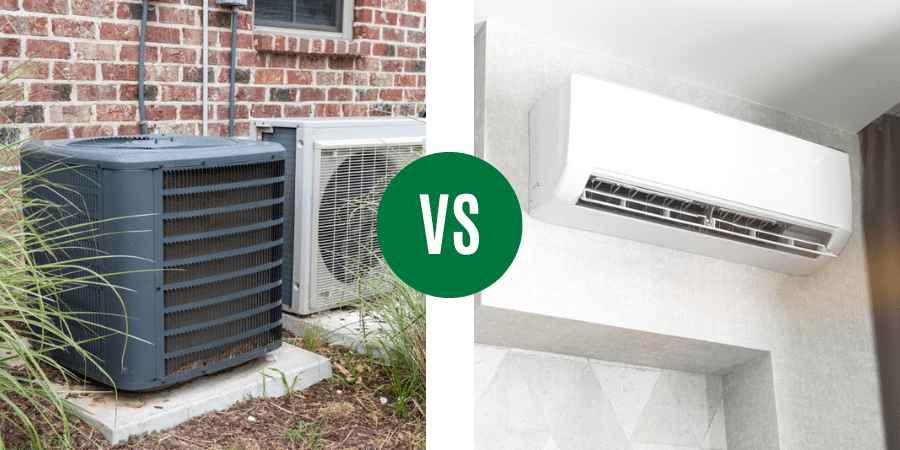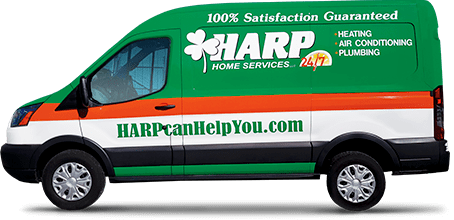
Ductless, mini-split systems are excellent energy-saving air conditioners, but are they right for your home or business? We’ll examine the main differences between mini-split vs. central air HVAC systems to help you determine which air conditioning system will work best for your space.
Mini-Split vs. Central Air
The main difference between a mini-split and central air HVAC system is that mini-splits are designed to heat or cool individual rooms, while central air systems are designed to heat or cool multiple rooms through ducts. We’ll highlight other key differences between mini-split vs. central air systems:
Energy Efficiency
When it comes to energy efficiency, this is where the mini-split system outshines central air. A few key ways mini-split and central air HVAC systems differ in energy efficiency:
- Mini-splits utilize ductless technology and only heat or cool the rooms they are in rather than the entire home.
- Central air systems can leverage a duct system to cool or heat more rooms at once, but it does use significantly more energy.
- Mini-splits have a higher SEER (Seasonal Energy Efficiency Ratio) rating because they have inverter technology that converts electricity into DC voltage, enabling the system to run on less energy than central air.
- Central air systems’ ducts become less efficient as they degrade, allowing conditioned air to escape before reaching the desired room.
Related: 3 Essential tips for finding an energy-efficient AC unit
Cost
When it comes to cost, you’ll pay less for utilities using a mini-split air conditioner vs. central air. But the installation cost is significantly more for a mini-split than a central air system. So is ductless AC worth it? Before you invest in a mini-split system, you’ll want to consider the following costs:
- Installation: Mini-splits are more expensive to install than central air systems. The US Department of Energy states that central air is a 30% higher cost to install vs. ductless mini-splits.
- Equipment: Mini-splits are typically more expensive to purchase than central air systems. This is because mini-splits are designed only to heat or cool individual rooms, and each unit must be purchased and installed separately.
- Maintenance: Central air systems have more components, making maintenance more time-consuming and expensive. We offer top-quality air conditioning services to ensure your maintenance costs remain low.
- Operating costs: Mini-split costs are generally lower than those for central air systems because mini-splits do not require as much power.
Want quality HVAC installation and maintenance at competitive pricing? Learn more about our air conditioning services.
Maintenance
In general, ductless mini-splits are easier to maintain than central air systems because mini-splits have fewer parts and are easier to access. But keep in mind both HVAC systems require regular maintenance to ensure efficiency and indoor air quality. When deciding between Mini-split and central air HVAC systems, you will want to consider the following:
- Mini-splits only require a small hole in the wall for the conduit and refrigerant line, making maintenance and cleaning easier.
- Central air systems ductwork collects dust and debris over time, reducing efficiency and indoor air quality.
- Both air systems have filters that need to be cleaned or replaced regularly to maintain efficiency and indoor air quality. Mini-split filters are typically easier to access and replace than central air filters.
- Central air systems have more components which creates more opportunities for maintenance repairs.
Adaptability/Use
When it comes to adaptability and use, this is mainly going to be driven by your home or business’s needs. To determine which air conditioning system is more adaptable and usable for your space, you’ll want to evaluate the following:
- Zoning: Mini-splits are designed to heat or cool individual rooms, requiring each unit to be installed separately. This makes them ideal for homes with multiple zones. Central air systems typically have one outdoor unit and one indoor unit, making them better suited for homes with open floor plans.
- Space restrictions: Mini-splits are ideal for homes with limited space for ductwork, such as historic homes or homes with little attic or crawl space.
- Room additions: If you add rooms to your home in the future, installing mini-splits to the new space may be easier than extending the ductwork for a central air system.
- Noise: Mini-splits can be quieter than central air systems because they don’t have an air handler and ductwork that can amplify noise.
- Want the latest in HVAC performance? Contact us to learn more about the latest HVAC technologies and systems.
Related: Single-stage, two-stage, and variable speed air conditioners
Mini-Split vs. Central Air: Which One is the Best?
The best HVAC system for a specific home depends on the size of the house, its layout, and the homeowner’s individual needs. There is no one-size-fits-all answer.
That said, Ductless mini-splits are more energy-efficient for smaller homes or homes with multiple zones, where individual rooms can be heated or cooled as needed. Central air systems are more efficient for larger homes with open floor plans, where it is more cost-effective to cool or heat the entire home all at once.
When determining the air conditioning system for your home or business, you should consider the following:
- Home size and layout: A central air system may be more cost-effective if you have a large home with an open floor plan. If you have a smaller home or a home with multiple zones, mini-splits may be a better choice. A mini-split may be a good idea if you’re adding a room to your home.
- Energy efficiency: If you live in an area with high utility costs, you may want to go with a mini-split system. Both HVAC systems can be energy-efficient, but mini-splits are more energy-efficient because of their newer, innovative technology.
- Cost: Mini-splits are more expensive to purchase than central air systems, but they have lower operating costs. So this will largely depend on how long you plan to stay in the home because the ROI on a mini-split might be better long term.
- Maintenance: If you’re really concerned about maintenance, mini-splits are generally easier to maintain than central air systems, as they have fewer parts and are easier to access.
Consult Harp Home Services for More HVAC Advice
Navigating the pros and cons of different HVAC systems can be challenging. Both a mini-split and a central air system can work for your home or business. At HARP, we are experts in air conditioning and heating and can help you identify your home’s needs and requirements. If you want advice on the best air conditioning system, contact Harp Home Services.


